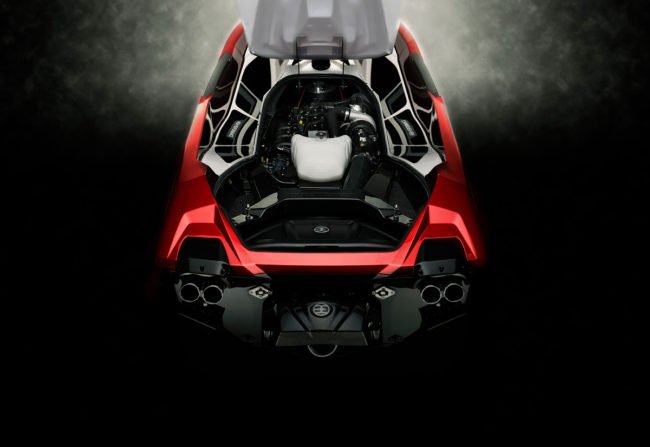OK, we had our fun with yesterday’s article, now it’s time to get to work. What exactly is this “Burrasca” anyways? Well, for those paying attention, one-time Benelli became Belassi, and the B3R, which in its earliest form (for the better part of half a decade or so ago), was a 3-cylinder, turbocharged 2-seater runabout pushing over 330-horsepower (that is, reportedly). We’re trying to keep the snark out of our tone, but the on-again, off-again legacy of both the watercraft maker and its fabled runabout is the stuff of legend. From its narrow, Fomula 1 style nose, rigid seat and cuts-you-like-a-knife edges made the machine absolutely sexy, but all but impossible to produce – at least in any major quantities.
And let’s just ignore literally years of no-shows to major unveilings, a procession of unsubstantiated claims, pie-in-the-sky promises to would-be dealers, and y’know, a complete and total disregard for any sort of compliance with the standing United States Coast Guard requirements thus permitting the vehicle to be sold within the single-largest marketplace on the planet. Rather, in recent months, Belassi has pushed to get the word out about their latest iteration of the rechristened runabout. Named “burrasca” (pronounced “burr-as-ka”; and explained as the Italian translation for “storm” but more appropriately translated as “squall”), Belassi hopes it to be equally as formidable.
To accomplish such a goal, Belassi began by employing both the very best in materials and minds at their disposal. 2016 IJSBA World Champion György Kasza was enlisted to help develop and test a unique hull lined with “internal carbon fiber multi-layer reinforcements” capable of achieving 4g in the corner. In addition to the carbon fiber, Belassi has imbued the Burrasca with a king’s ransom in state-of-the-art materials, including aerospace-grade aluminum, automotive paint and forged carbon composites. As per Belassi, the “hull and deck [are] made of infused high performance composites” reinforced with a full carbon 3K X-frame, with a “high-serviceability hood, seat frame and base, side covers, rear spoiler and exhaust covers are all made of full 3K carbon fibre.”
This keeps the total dry weight down to a featherweight 350kg (772 pounds), particularly for a 143-inch (11-foot, 11-inch) long, 46-inch (3-foot, 8-inch) tall 2-person runabout. Considering its 60L (15.8 gallon), and absurdly advanced cooling and oiling system (more on that in a minute), this machine will hold quite a bit of fluids, bumping that total weight nearly 200-pounds (with a full tank of gas, 5-quarts of oil and a full 1.5 gallons of coolant). All of that carbon fiber and aluminum comes in handy when that machine starts getting into fully-loaded Sea-Doo GTX 300 Limited territory. Nevertheless, Belassi is positive its sum with will far out value its 2,000 parts.
Although years of claiming 333-horsepower have suddenly gone silent from Belassi’s newest announcement, what we do know is quite a bit about its powertrain: entirely unique to Belassi, the turbocharged I3C16 Marine 3 cylinder 4-stroke displaces 1602cc (100mm bore x 68mm stroke), spinning a forged crankshaft, connecting rods and 9.1:1 compression pistons through NSC coated cylinder liners. The block itself is a closed deck with a bedplate made from gravity-casted aluminum that has been EPD coated (or anodizated) to protect the engine’s external surface against corrosion. It’s topped with a direct-acting 4-valve-per-cylinder dual-overhead camshaft (DOHC) cylinder head and a “high tech forged carbon” valve cover.
The I3C16 is force fed by a single scroll turbocharger (with an integrated water cooled aluminum turbine housing with watercooled cartridge), waste gate valve and pulse valve to control boost pressures, and a water-cooled intercooler circulating through a closed loop cooling system with a heat exchanger integrated into the jet pump. Impressively, the engine is oiled via a gear-driven 6-stage dry sump system feeding into a 3K carbon fiber reservoir and heat extractor. Equally impressive is the water-injected exhaust system flowing into a full carbon 3K muffler with double chromed exhaust tips, giving the Burrasca its Italian supercar look.
Finally, the engine is managed by Belassi’s SMPI-K sequential multi-point injection (with knock control) featuring Belassi’s Adaptive Ride System providing the rider with warning messages, steering, nozzle and mode display functions on a secondary dashboard. The primary digital display features integrated GPS and is operated via co-molded soft touch buttons (or steering bar switches in dual machined-aluminum housings mounted to an adjustable-angle steering system), and provides warning lights for low oil pressure, low fuel level, overheating Indications of boost level, engine rpm, vehicle speed (mph or km/h), hour meter, fuel level, trip, GPS position.
The jet pump begins with an aluminum housing with an integrated heat exchanger for the engine’s closed-loop cooling system, a stainless steel sleeve, a single-stage axial flow 7-vane stator, and a stainless 3-blade prop. The Burrasca’s trim system (VET: standing for Variable E-hydraulic Trim System) employs axial displacement cylinders to engage the electric trim. Both the intake grate and ride plate are made from cast aluminum. Belassi also provides its own take on Sea-Doo’s iBR with DBS (Dynamic Brake System); deploying both a reverse flap made from full 3K carbon fiber (with forged aluminum brackets), and E-Rev, an E-hydraulic Reverse System with “axial displacement cylinders” as well. Most unique is the Burrasca’s adjustable cast-aluminum rear flaps. Yup, functioning trim tabs on a factory-equipped PWC.
Belassi is praising its engineers as artisans, combining two’s strengths of “engineering and technology with the uniqueness of true craftsmanship,” uniting the two in a small production site providing superior hand-craftsmanship over mass produced would-be competitors. As stated in the official press docket, in “early 2015, Belassi was inspired by the concept of a “Manufaktur“, and restructured its engineering, product development as well as partners and suppliers” to better focus on individualization, hand-craftsmanship and “valuing pure quality.” So while each Burrasca is certain to be its own unique machine, hand-built to the buyer’s specifications, it will be a watercraft roughly the same cost as a moderately-optioned SUV. Details beyond what is listed here are absent, so we’ll have to wait and see whether this “dream machine” truly materializes or fades into legend like so many times before.

























I find it worrying that they can’t spell the word ‘choice’….
Some things get lost in translation.